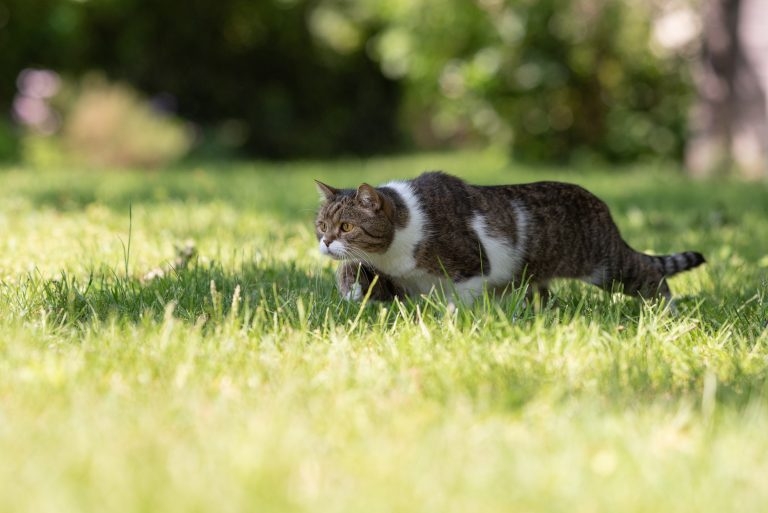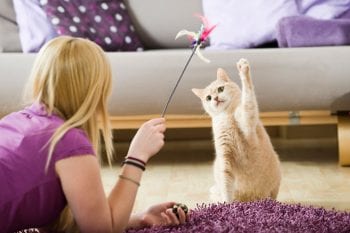19 Feb 2021
Few minutes per day with cats will be rewarded with fewer birds and rodents brought home, according to University of Exeter study.

Image: © FurryFritz / Adobe Stock
Cat owners who spend a few minutes each day playing with their pet will be rewarded with a reduction in the number of small animals it kills and brings home, a study has shown.
Researchers led by Robbie McDonald, of the University of Exeter Environment and Sustainability Institute, were looking for feline welfare‑friendly ways to curb a cat’s appetite for hunting birds and rodents.
The only guaranteed method for stopping cats from catching and killing their prey is to confine them indoors, which many owners believe will adversely affect their welfare. Owners are also sceptical about the effectiveness of traditional strategies used to reduce a hunting cat’s success rate, such as collars with bells. Many worry a collar would be lost if it was too loose and could strangle the wearer if too tight.
The team recruited the owners of 355 cats known to regularly catch wildlife prey and tried a range of different strategies aimed at reducing the desire to hunt, rather than impeding its effectiveness.
The results, published in the journal Current Biology, show two particular interventions were successful in reducing the numbers of corpses brought home during the 12-week trial – changing the cat’s diet and increasing the time it spends interacting with its owner.
The owners encouraged the pet to chase and catch a toy for between 5 and 10 minutes a day. This strategy reduced the frequency that rodents were caught by the cat by as much as 35%, although it was less effective at reducing the numbers of birds killed.

Another successful strategy was to replace the cat’s normal diet with a fresh meat ration that contained none of the plant-based protein found in most commercial cat foods. This produced an even bigger change in hunting behaviour, reducing the number of birds and rodents caught by 36%, although the reasons for this effect are unclear.
Prof McDonald speculated hunting may be stimulated by a need to find a specific mineral or amino acid. He said: “It is not so much an overall deficiency, since the cats should all be on ‘complete’ diets. However, we suspect some cats – especially those that hunt wildlife – might still want or need a little extra of some particular nutrients that even a complete diet might leave them wanting more.”
This question may be answered in further studies the Exeter team is keen to carry out.
Another focus of further research will be the discovery that cats given dried food in puzzle feeders went out and caught a third more birds and rodents than before the study began. The devices are often recommended to owners as a way to make cats work for their food to minimise obesity and boredom.
Feline behaviourist Sarah Ellis, of International Cat Care, agreed the finding was surprising, but felt a rational explanation may exist.
She said: “Some owners find that their cats do not maintain an interest in the puzzle feeders and so, at some periods of the day, they may be left hungry. We do know that hunting is stimulated by hunger – this theory can be tested by presenting the puzzle feeders in different ways.”
Other strategies tested in the study produced mixed results. No change occurred in the hunting success of cats fitted with a traditional collar and bell, while a proprietary Birdsafe collar did reduce the number of birds caught, but not rodents. The collars are made of soft coloured material and may be more use in controlling hunting during the day than at night.
Dr Ellis said she believed much more needed to be done in persuading owners that this option would work. She said: “Some owners in the study reported that their cats lost the collars or found them uncomfortable to wear. Also current societal norms make some owners feel their cat looks silly wearing such a collar.”
Dr Ellis said she believed increasing the time spent in play would benefit both cat and owner. She said: “It was reported by some owners that they felt closer to their cats as a result of this intervention. Cats were engaged with play and some even solicited the play, a behaviour I am sure many owners will find appealing.”
The study was supported by the charity SongBird Survival, which is keen to explore ways to reverse the decline in numbers of many wild bird species.
RSPB spokesman Helen Moffat welcomed the research, but was not convinced cat predation was a significant factor behind those trends.
She said: “Although cats kill millions of birds and small mammals each year, there is no clear scientific evidence that this is a major cause of the decline in any bird species in the UK. Changes in land-use causing habitat loss is the main driver of bird population changes.”